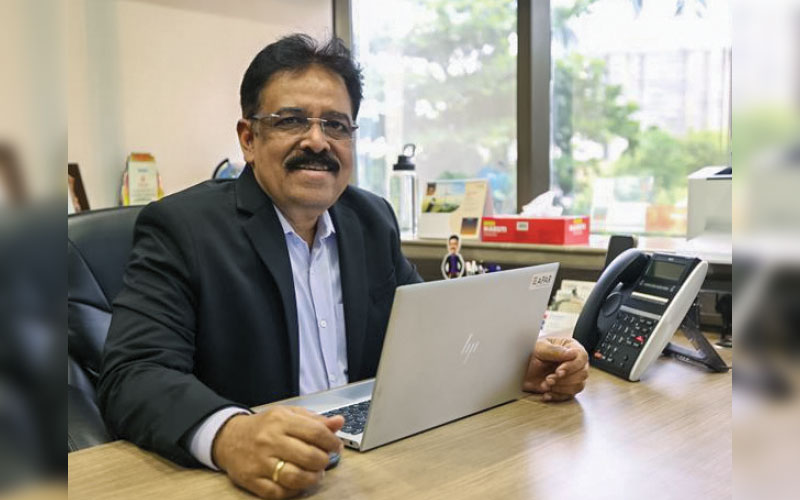In an exclusive conversation with Wire & Cable India, Mr. Shashi Amin, CEO of APAR Cable Solutions, discusses how the company is powering India’s solar ambitions by delivering advanced 1.5 kV DC-compatible solar cables and harnesses. APAR is leveraging e-beam crosslinking technology to ensure superior thermal endurance, environmental resistance, and 25+ years of product life. With TÜV, UL, and CPR certifications, and strong global traction, APAR continues to innovate for utility-scale, floating, and hybrid solar projects, reducing BOS costs while meeting international benchmarks.

Wire & Cable India: As India increasingly adopts 1.5 kV DC architectures to reduce BOS costs and improve efficiency, how has APAR adapted its cable designs regarding insulation, thermal performance, and reliability?
Shashi Amin: APAR evolved its solar cable design to support these higher-voltage configurations by utilising e-beam crosslinked insulation and sheathing made from halogen-free thermoset compounds. This approach delivers enhanced dielectric strength, thermal class up to 120°C continuous operation, and broad environmental resilience including UV, and ozone resistance.
This improvement allows for reduced conductor cross-sections without compromising ampacity, optimising current density and lowering BOS costs. Our products undergo rigorous type testing to meet global standards, ensuring robust performance and a lifespan exceeding 25 years.
Additionally, we supply value-added solar harnesses that can reduce electrical contractor installation costs by over 30%, cut cable consumption by more than 30%, and prevent over 10% of cable wastage typically caused during direct installation. This makes using solar harnesses a significantly more efficient and cost-effective alternative to conventional wiring.
Watch: Top Cable Companies in India
WCI: What role does electron beam (e-beam) cross-linking technology play in your solar cable manufacturing, and how does it compare to conventional methods in performance and cost-efficiency?
SA: E-beam cross-linking is fundamental to APAR’s solar cable performance and durability. Unlike traditional chemical cross-linking, e-beam technology offers a clean, uniform process without needing chemical initiators, resulting in superior thermal stability, enhanced mechanical strength, and improved resistance to UV, ozone, and moisture crucial for long-term outdoor solar applications.
Cables with e-beam crosslinked insulation consistently operate at temperatures up to 120°C and show minimal aging, shrinkage, or dielectric degradation under high-voltage stresses typical of 1.5 kV systems.
While the initial investment is higher, the long-term lifecycle savings, plus operational reliability, make this technology highly cost-effective for utility-scale solar projects, underlining APAR’s commitment to advanced, next-gen solar solutions.
WCI: With floating solar and hybrid solar-plus-storage systems on the rise, how are your cables engineered to handle environmental extremes like water submersion, high UV exposure, or EMI interference?
SA: Floating solar and hybrid systems demand robust cables capable of withstanding extreme conditions. Our solar harness assemblies are engineered for harsh environmental exposure, certified AD8 per EN 50525-2-21:2011 to endure prolonged water immersion, essential for floating PV farms and water-based renewable projects.
Our cables demonstrate superior environmental resistance combining e-beam crosslinked halogen-free compounds that guarantee thermal endurance (up to 120°C), long-term UV stability, and water tightness as global standards.
To address hybrid system challenges, we offer shielded cables with low transfer impedance for EMI mitigation and enhanced grounding integrity, ensuring safety in sensitive installations.
Additionally, our cables incorporate rodent-resistant features, to prevent damage and ensure uninterrupted operation, an important benefit for solar farms in regions prone to rodent activity.

We supply value-added solar harnesses that can reduce electrical contractor installation costs by over 30%, cut cable consumption by more than 30%, and prevent over 10% of cable wastage typically caused during direct installation
WCI: Can you walk us through your quality assurance processes, especially concerning BIS compliance, fire safety, and lifecycle testing under IS or IEC standards?
SA: Quality assurance is integral at APAR, implemented across all stages from raw material selection to final product testing. Our solar and power cables are BIS-certified and tested against applicable IS (e.g., IS 7098, IS 694) and IEC (e.g., IEC 60228, IEC 60502, IEC 62930) standards.
We employ in-line process controls such as spark testing and high-voltage withstand checks to maintain zero defects. For fire safety, comprehensive testing against IEC 60332 (flame retardancy), IEC 60754 (halogen content), and IEC 61034 (smoke density) ensures compliance. Lifecycle assessments include accelerated aging, thermal cycling, UV exposure, water immersion, and dielectric strength validation simulating 25+ years of field operation, guaranteeing reliable, safe performance in all environments.
WCI: What raw material trends are you observing, particularly in conductor metals and insulation compounds? How are you balancing performance with price volatility?
SA: We observe significant industry shifts towards high-conductivity aluminium alloys as an economical alternative to copper, offering favourable strength-to-weight ratios and lower price volatility.
In insulation, halogen-free, flame-retardant, e-beam cross linkable compounds dominate, meeting demanding thermal, UV, and fire safety specifications essential for solar, EV, and green building sectors.
To balance performance with market fluctuations, APAR employs a dual-material strategy, backward integrates key compounds, and maintains close supplier relationships ensuring consistent quality without sacrificing competitive pricing.

We observe significant industry shifts towards high-conductivity aluminium alloys as an economical alternative to copper, offering favourable strength-to-weight ratios and lower price volatility
WCI: Are you seeing increased traction from global EPCs or exports for Indian-made solar cables? If yes, what certificates are most demanded internationally?
SA: Yes, there is growing demand internationally, with APAR’s solar cables and harnesses deployed in utility-scale projects across the USA, Europe, Middle East, Africa, Southeast Asia, and Latin America.
International clients prioritise compliance with certifications such as TÜV (EN 50618, IEC 62930), UL 4703 (for the US market), and Construction Products Regulation (CPR) for Europe.
Beyond electrical and mechanical standards, focus areas include long-term UV resistance, water immersion performance (critical for floating PV), and halogen-free, flame-retardant construction.
APAR’s integrated manufacturing and testing capabilities consistently meet these global benchmarks, positioning it as a trusted partner for EPCs worldwide.
WCI: What are the key challenges solar cable manufacturers in India face today—whether certification costs, skilled workforce shortages, or price-driven procurement? How are you tackling them?
SA: India’s solar cable industry faces various challenges. Firstly, certification costs and delays for international benchmarks like TÜV, UL, and CPR are significant. At APAR, in-house R&D and NABL-accredited labs accelerate certifications and reduce external dependencies.
Second, price-driven procurement pressures risk commoditisation and quality compromises. APAR counters this through stakeholder education on lifecycle value and demonstrating the superior reliability of e-beam, halogen-free cables suited for India’s climate and voltage levels.
Third, skilled workforce shortages amid evolving cable technologies are addressed by comprehensive training and upskilling programs, ensuring teams maintain global quality standards.
Also Read: Orbit Cables Elevates Solar Cable Quality with Rigorous Testing and Standards Compliance
WCI: Finally, how is India’s solar cable manufacturing, especially in material technology, certifications, and testing infrastructure, compared to global benchmarks like Europe, the U.S., or East Asia? What areas require improvement for India to become a global supply hub?
SA: India’s solar cable manufacturing has advanced substantially. Manufacturers like APAR use state-of-the-art materials including halogen-free, flame-retardant compounds and e-beam crosslinking, aligned with global standards.
India has also invested in TÜV-certified processes and NABL-accredited labs, mirroring developed markets. However, some of the challenges that still remain are- Industry-wide enforcement of consistent quality is uneven, some manufacturers prioritize upfront cost over long-term reliability, and greater access to e-beam crosslinking and expedited export certifications would boost competitiveness.
APAR actively invests in standardising quality, expanding advanced testing infrastructure, and driving R&D in next-generation materials to support India’s ambition of becoming a global supply powerhouse.

There is growing demand internationally, with APAR’s solar cables and harnesses deployed in utility-scale projects across the USA, Europe, Middle East, Africa, Southeast Asia, and Latin America






